Receive free Chinese economy updates
We’ll send you a myFT Daily Digest email rounding up the latest Chinese economy news every morning.
China has said it will stop publishing data on youth unemployment, weeks after the gauge hit a record level, in a sign of mounting pressure on policymakers as new data pointed to weakness in the recovery of the world’s second-largest economy.
The People’s Bank of China on Tuesday also unexpectedly cut a benchmark interest rate by the biggest margin since the start of the coronavirus pandemic, in a further sign of official concerns over a loss of momentum months after Covid-19 restrictions were lifted.
Beijing is grappling with a host of economic challenges, including a liquidity crisis in the property sector, a sharp fall in exports, flagging foreign investment and sustained weakness in consumption.
Youth unemployment, which China began reporting in 2018, hit 21.3 per cent in June, but the figure was not included in a wider data release for July on Tuesday. The report largely undershot expectations and showed growth slowed in retail sales and industrial production, two intended engines of the country’s economic recovery.

Retail sales added just 2.5 per cent year on year in July, while industrial production expanded 3.7 per cent. Both metrics missed forecasts and were below June’s figures of 3.1 and 4.4 per cent, respectively. The general unemployment rate was 5.3 per cent in July, up from 5.2 per cent in June.
The yield on 10-year Chinese government bonds fell 0.05 percentage points to 2.572 per cent on Tuesday following the announcement, while the renminbi slipped as much as 0.4 per cent against the dollar to Rmb7.2864. China’s benchmark CSI 300 index of Shanghai- and Shenzhen-listed stocks was down 0.5 per cent.
The exclusion of China’s youth joblessness rate will compound the challenges of parsing the country’s economic data, which analysts say has become more difficult in recent years.
Labour statistics needed to be “advanced and optimised”, said Fu Linghui, spokesperson for the National Bureau of Statistics.

The PBoC on Tuesday cut its one-year medium-term lending facility rate, which affects loans to financial institutions, by 15 basis points to 2.5 per cent. The rate, which was also reduced in June by 10 basis points, is now at its lowest level since it was launched in 2014.
While Beijing has stopped short of unleashing major stimulus, further cuts to borrowing costs for businesses and households are expected next week. The central bank on Tuesday also trimmed the seven-day reverse repurchasing rate, which manages short-term banking liquidity, by 10 basis points to 1.8 per cent.

“The market was expecting the PBoC to wait until September before easing again, and today’s cuts suggest that the authorities’ concern about the state of the macroeconomy is mounting,” Robert Carnell, head of Asia-Pacific research at ING, wrote in a note.
“If it isn’t there, it must be bad news,” he said of the unemployment figures.
Fears of slow growth in the property sector, which has been paralysed for two years by dozens of developer defaults, have been renewed in recent days after Country Garden, China’s largest private homebuilder, missed payments on international bonds. Entities linked to Zhongzhi, a major domestic conglomerate, have also missed payments on investment products.
New construction starts were down 24.5 per cent year on year in the January-July period, official data showed on Tuesday. Property investment dropped 8.5 per cent, worsening from a 7.9 per cent fall in the first half.
Additional reporting by Andy Lin and Hudson Lockett in Hong Kong








